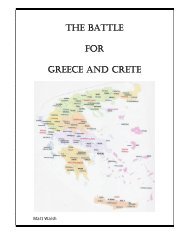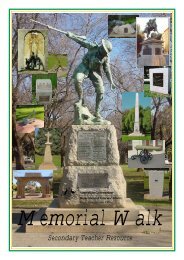Eastern Adelaide Teacher resource.pdf - Army Museum of South ...
Eastern Adelaide Teacher resource.pdf - Army Museum of South ...
Eastern Adelaide Teacher resource.pdf - Army Museum of South ...
Create successful ePaper yourself
Turn your PDF publications into a flip-book with our unique Google optimized e-Paper software.
Classroom<br />
(8) As a tribute to those ten servicemen from Tea Tree Gully, who lost their<br />
lives in the two World Wars, the local community planted the ‘Avenue <strong>of</strong><br />
Trees’. These trees originally had plaques bearing the names <strong>of</strong> the fallen.<br />
They have now all disappeared. Write a letter <strong>of</strong> 50 –100 words to the<br />
editor <strong>of</strong> the local paper arguing for these plaques to be replaced.<br />
Student answers should reflect the contribution and sacrifice made by these ten<br />
servicemen during the two World Wars.<br />
<strong>Teacher</strong>s note: Students may also be encouraged to write to their local member <strong>of</strong><br />
Parliament or local RSL branch requesting that they argue for the replacement <strong>of</strong><br />
these plaques.<br />
(9) The very last name on the Tea Tree Gully World War I plaque, which you<br />
recorded in Question (7), is that <strong>of</strong> a famous World War I veteran who died<br />
on July 26 2002 aged 102. His first name was Albert. However he was<br />
better known as Bert. Use the internet to find out why he was so important.<br />
Albert (Bert) Whitmore will be remembered because he was the last <strong>of</strong> the World<br />
War I Australian Light Horsemen and the last <strong>South</strong> Australian World War I veteran.<br />
He was honoured by a State Funeral when he passed away. The Australian Light<br />
Horse were mounted infantry. Light Horsemen served at Gallipoli with distinction and<br />
some also served on the Western front. However they are best known for their<br />
campaigns in Egypt and the Middle East from 1916-1918.<br />
<strong>Teacher</strong>s note: By birth, upbringing and training, Whitmore fitted<br />
into the mould <strong>of</strong> a Light Horseman perfectly. Born, as he said, "way<br />
out in the bush" in the then hamlet <strong>of</strong> Tea Tree Gully, 20km north<br />
east <strong>of</strong> <strong>Adelaide</strong>, he was put in the saddle before he could walk. His<br />
first job on leaving primary school was mustering sheep on<br />
horseback. The 17-year-old was still riding to and from his <strong>Adelaide</strong><br />
Hills job as an apprentice baker when he enlisted on March 5, 1917,<br />
putting his age up and passing the riding test at first go. Trained in<br />
Mitcham in <strong>South</strong> Australia and in Seymour, Victoria, he joined the<br />
9 th Light Horse Regiment and sailed for Port Suez. He was taught<br />
desert warfare before joining the campaign at Gaza, just west <strong>of</strong><br />
Beersheba, which his countrymen had just captured. The 9 th Light<br />
Horse then liberated Gaza from Turkish and German occupation to<br />
open the way to Jerusalem. Whitmore rode into the fray in the<br />
successful third battle for Gaza.<br />
Riding north along the Mediterranean coast, they occupied Jaffa, Bethlehem and<br />
finally Jerusalem. "It was like riding through the Bible," Whitmore said. He then<br />
served in the Jordan Valley with the 9 th , and "rode <strong>of</strong>f at a gallop" on the famous Es<br />
Salt Raid in April 1918 to help the Allied Light Horse advance from the east towards<br />
enemy positions still held by enemy forces in Palestine. In this operation, they rode<br />
over the high plateau at Moab to the River Jordan, helping to gain and then guard an<br />
Allied crossing despite enemy fire at Es Salt. When enemy forces counterattacked<br />
40











